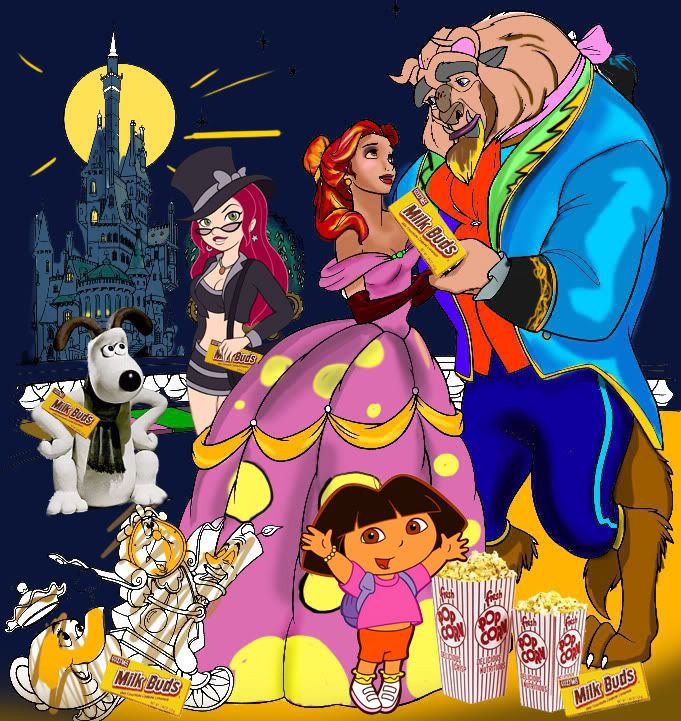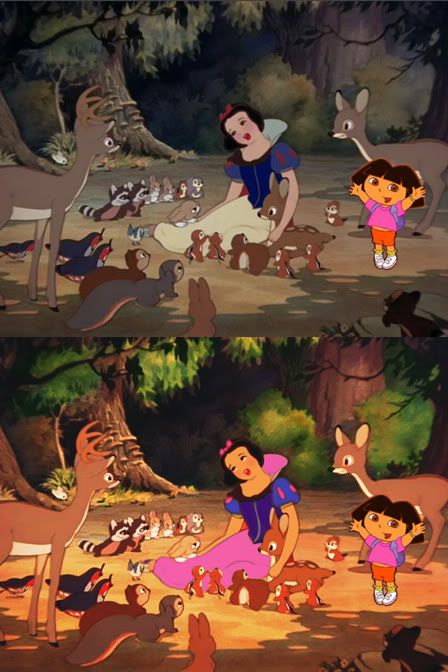So? If I can see it on YouTube and I don't see it on my BD on my calibrated TV, what does that mean? That if my display is accurately reproducing the image on the media, then I won't see what someone uploaded to YouTube? Good. I'd hate to watch it looking all wrong and stuff.
Ok before we go further I need to know what the actual position of the disney apologists is.
Is it. The 'restoration' is the original intent of the movie, but is different from the theater/LD/VHS.
I'm not an apologist, I'm a realist.
And I don't think you get "intent."
Making a motion picture, staging a play or dance---these things are exercises in compromise. Nothing is ever completely finished, nothing is a perfect rendering of what was envisioned at the beginning of the process. Time, money, available tools: all of these play a part, and sometimes there are ideas or issues you just have to let go in order to get finished in time for an opening. As a former tech director of mine used to say, "Done is beautiful."
So, CAPS. Anyone here qualified to give an in-depth lecture? No? Me either. What do we know? That it was a new process, an new way of making an animated film. It was unique and proprietary, built from the ground up, hardware and software that doesn't have any meaning or function outside its closed system. And now, 20 years later, the whole kit and caboodle is obsolete from one end to the other.
What is the source? Tricky question. Everything done by hand has to get into the computer somehow, so you digitize a piece of artwork. Suddenly there's no "there" there anymore: what was a piece of empirical stuff in the real world has been rendered as data. You can't reach out and touch it. There's a technological layer between us and the art, a layer without which there is nothing, no meaning, nothing to look at. The artwork has become a technological representation of itself. In scanning it had to go through hardware and software; it has go through hardware and software to be realized on a display. With perfect execution on the human side---no user error---you're entirely dependent on the technology for bringing the work into the domain where the production will be done, you're entirely dependent on the technology to execute the work, and you're entirely dependent on the integrity of the technology to *show* you what's going on. This film was produced with a system that's now twenty years past its freshness date for state-of-the-art.
And then by some magic pixie dust process, that digital imagery had to get put on film. Anybody know how? I don't. Is there something at the end of the CAPS line that spits out finished film? Is it a positive print? Is it negative? And hasn't this thread already covered in some detail the many issues in realizing a perfect physical reproduction of what you see on your monitor?
The goal was to make a motion picture, and the film they released was de facto the best possible realization of their intent. That doesn't mean they were completely satisfied. Artists never are, virtually by definition: the urge to create is born of divine discontentment. Every filmmaker on earth will point to things in their work they shouldacouldawoulda done differently. I doubt Belle was supposed to be Girl of a Hundred Noses---I don't think that was part of the plan. I don't think any of the other noted continuity issues were what they envisioned. So if at the end of the day the scan wasn't a perfectly accurate reproduction of the artwork, and the monitor wasn't perfectly reproducing the scan, and the film transfer---however that even happens---isn't a perfect reproduction of the digital image, then you take what you've got, having done the best you could in an imperfect world. And even if the results are as good as it can get up to that point in the process, you've got to make release prints, the films actually shown in theatres, which are photographs of photographs of photographs, transiting through a completely different domain of volatile chemical processes and materials, further generations removed, on a media we perceive completely differently (projections reflected off a screen) than that in which the work was produced (directly-emitted light from a display). And what actually happens at the theatre is completely beyond your control: last film-based presentation I saw in a cinema was Ratatouille, for example. It had been running all of two weeks, it was beat to crap, exhibiting wear & damage, specks, dirt, there were some *weird* color timing shifts at reel changes, the presentation was so dim I assumed the lamp was on its last legs, the picture was out of focus...and that was the first time I figured I'd be better off at home in high-def if I wanted to see something more closely resembling the movie the filmmakers wanted me to see. There are a thousand reasons why a finished motion picture will fall short of the filmmakers' hopes and expectations---they may not know exactly where they'll have to cut or compromise or let something ride, but they know from the get-go that's how the cookie crumbles. It's a hugely complicated endeavor all the way around.
VHS & laserdisc are too constrained to accurately reproduce the theatrical experience, period. Limited resolution, limited color space, volatility in authentic color reproduction---all best efforts and intentions taken for granted, that's some weak sauce media. Period. And what went on it was transited through another domain, further removed from where ever this train ride started, and reduced exponentially in every single quality metric. Objectively speaking, there's no way those releases could comprise a most-accurate replication of the film. And you can't say the VHS or laserdisc colors are "right" because you're relying an a couple hours' experience in a theatre twenty years ago, and you're weighing that against the authority of those who've spent hours daily over weeks and months in the past twenty years immersed in this motion picture, handling artwork, monitoring compositing, screening film, participating in three generations' worth of home media releases. How on earth can you declare yourself to be qualified to know how it should look or has looked on any medium ever? How? How can you claim this looks like garbage? On what hook do you hang that hat? What do you know about animation and color timing and post-production and photography and making this particular movie and releasing it again and again over twenty years that Don Hahn doesn't know---that *you* know *better*? When you have no meaningful relationship with the processes involved, how can you question whether *any* home media release is anything other than at least a good-faith effort? Do you own the BD? Is your TV calibrated? Have you ever in the history of your viewing experience made a good-faith effort to confirm the integrity of your TVs color reproduction, for any medium?
I read ranting and I read raving, and it's all about what it looked like twenty years ago with nothing to point at. I owned the VHS, haven't seen it in ages. I thought then it was too dark and disappointing. I only ever owned 4 VHS tapes, all Disney features. They were all too dark, come to think of it. Never dreamed of actually monkeying with color and tint and brightness to achieve any kind of standard, though. I just plugged and played. Same for the DVD. Seemed kinda bright. Colors seemed a little...something. Whatever. Didn't really bother me much. Never really thought about picture settings.
Now I've got the BD, and I've finally had a chance to spend a little time with it. And my TV has been calibrated and recalibrated every time it's changed locations in the past few months. It's finally come to rest where I can watch the 32" screen from not quite 4' away, which is pretty close to optimal for field-of-vision immersion in recreating the theatrical viewing experience. I watched it in a darkened room. And I think it looks pretty amazing. I'm not going claim I remember the original theatrical experience well enough to debate the palette, but I never felt that experience was violated. It seems bright, yes--though I quit thinking that after my eyes were completely adjusted. But it's not just bright, it's *dark*, black-blackety blacks. Every so often I think I'm getting used to HDTV, and then I realize I'm astounded at the dynamic range of the reproduction in front of me. At that observation extends to the color. I saw nothing shocking or unnatural, ever. What I saw was rich and vibrant and consisted of a *huge* array of hues. Belle's hair, for example, is almost *always* affected by surroundings and the dynamics of the direct and/or indirect lighting as designed, some tint or shading in play, and honestly I quit trying to keep track of them---I saw traces of honey and peach and rose and deepest chocolate, depending on the circumstances, but there's no question she's a brunette. No pink pages. It was a different experience, but in no way opposed to what I think I remember I saw.
And when I got to "Be Our Guest"...that was a seminal Disney moment for me, seeing that in the theatre---it left the most profound impression of anything that's been done by the animation studio since Walt died, it was a crystallization of potential and standards that really set the bar for me for what I expected from the studio as an adult. Sitting in the best seat in the house, hearing it better than it ever sounded in the theatre, watching that brilliance unfold...*that* took me back. *That* was spot-on.
Only it was better.
My experience: I feel like I've seen more of this film than I've ever seen before. And I am pleased.
My opinion.












